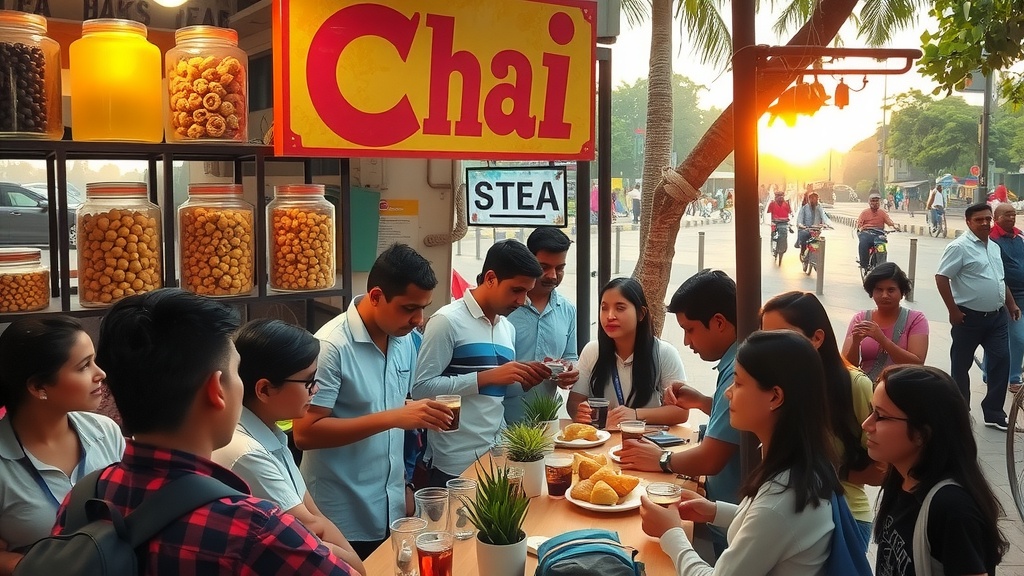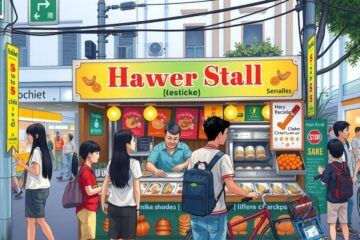Imagine strolling down a bustling street in Dhaka. The air is thick with the aroma of spices, the sounds of rickshaws clanging, and the constant chatter of people. But amidst all this sensory overload, one thing stands out: the inviting warmth of a chaa er dokan – a tea stall. For many Bangladeshis, the tea stall is more than just a place to grab a quick beverage; it's a social hub, a meeting place, and a vital part of daily life. Let's explore this iconic institution in a series of paragraphs suitable for students from Class 6 to HSC, covering word limits of 150, 250, and 300 words. We will also provide the paragraph bangla meaning.
A Tea Stall: The Heartbeat of Bangladesh
A tea stall, or chaa er dokan (চায়ের দোকান) in Bangla, is a ubiquitous sight across Bangladesh. It's a small, often makeshift establishment where people gather to enjoy a cup of tea, share stories, and discuss everything from politics to cricket. These stalls are more than just places to buy tea; they are vital social hubs that reflect the culture and spirit of the country.
A Tea Stall Paragraph for Class 6-8 (150 Words)
A tea stall is a small shop where people drink tea. It's a very common sight in Bangladesh. You can find them on roadsides, near markets, and in villages. The tea stall owner, often called chacha or mama, makes the tea. People come here to relax, chat with friends, and read newspapers. Tea stalls sell different kinds of tea, like milk tea and lemon tea. They also often sell biscuits, cakes, and sometimes even singara and samosa. A tea stall is a place where people from all walks of life can come together and enjoy a simple cup of tea. It's a very important part of our culture.
Bangla Meaning:
একটি চায়ের দোকান হলো একটি ছোট দোকান যেখানে মানুষ চা পান করে। এটি বাংলাদেশে খুবই সাধারণ দৃশ্য। আপনি এগুলো রাস্তার পাশে, বাজারের কাছে এবং গ্রামে দেখতে পাবেন। চায়ের দোকানের মালিক, প্রায়শই চাচা বা মামা নামে পরিচিত, চা তৈরি করেন। মানুষ এখানে বিশ্রাম নিতে, বন্ধুদের সাথে গল্প করতে এবং সংবাদপত্র পড়তে আসে। চায়ের দোকানে বিভিন্ন ধরণের চা বিক্রি হয়, যেমন দুধ চা এবং লেবু চা। তারা প্রায়শই বিস্কুট, কেক এবং কখনও কখনও সিঙ্গারা এবং সমুচা বিক্রি করে। একটি চায়ের দোকান এমন একটি জায়গা যেখানে সমাজের সকল স্তরের মানুষ একত্রিত হতে পারে এবং এক কাপ সাধারণ চা উপভোগ করতে পারে। এটি আমাদের সংস্কৃতির একটি গুরুত্বপূর্ণ অংশ।
A Tea Stall Paragraph for Class 9-10, SSC (250 Words)
A tea stall is an integral part of the Bangladeshi landscape, a place where people from all walks of life converge. Typically located on roadsides, near bus stops, or in busy marketplaces, these humble establishments offer more than just a beverage. They serve as social hubs, providing a space for conversation, relaxation, and community bonding. The aroma of freshly brewed tea, often prepared with milk and spices, fills the air, creating an inviting atmosphere.
The tea stall owner, affectionately known as chacha or mama, is a familiar and often respected figure. He skillfully prepares tea, often using a traditional clay oven or gas stove. Besides tea, these stalls usually offer light snacks such as biscuits, chanachur, and sometimes even singara or puri. Regular customers often engage in lively discussions on current affairs, politics, or sports, making the tea stall a microcosm of Bangladeshi society.
A tea stall is not just a place to quench one's thirst; it represents a cultural tradition, a space for social interaction, and a platform for the exchange of ideas. It's a place where friendships are forged, debates are ignited, and the pulse of the nation can be felt. It’s a testament to the simple pleasures of life and the importance of community in Bangladeshi culture.
Bangla Meaning:
একটি চায়ের দোকান বাংলাদেশের ভূদৃশ্যের একটি অবিচ্ছেদ্য অংশ, যেখানে সমাজের সকল স্তরের মানুষ একত্রিত হয়। সাধারণত রাস্তার পাশে, বাস স্টপের কাছে বা ব্যস্ত বাজারগুলোতে অবস্থিত, এই সাধারণ স্থাপনাগুলো কেবল একটি পানীয়ের চেয়েও বেশি কিছু সরবরাহ করে। তারা সামাজিক কেন্দ্র হিসাবে কাজ করে, যা কথোপকথন, বিশ্রাম এবং সম্প্রদায়ের বন্ধনের জন্য একটি স্থান সরবরাহ করে। সদ্য তৈরি চায়ের সুবাস, প্রায়শই দুধ এবং মশলা দিয়ে প্রস্তুত করা হয়, বাতাসে ভরে যায় এবং একটি আমন্ত্রণমূলক পরিবেশ তৈরি করে।
চায়ের দোকানের মালিক, স্নেহের সাথে চাচা বা মামা নামে পরিচিত, একজন পরিচিত এবং প্রায়শই সম্মানিত ব্যক্তি। তিনি দক্ষতার সাথে চা তৈরি করেন, প্রায়শই একটি ঐতিহ্যবাহী মাটির চুলা বা গ্যাসের চুলা ব্যবহার করে। চা ছাড়াও, এই দোকানগুলো সাধারণত বিস্কুট, চানাচুর এবং কখনও কখনও সিঙ্গারা বা পুরির মতো হালকা খাবার সরবরাহ করে। নিয়মিত গ্রাহকরা প্রায়শই সাম্প্রতিক ঘটনা, রাজনীতি বা খেলাধুলা নিয়ে প্রাণবন্ত আলোচনায় অংশ নেয়, যা চায়ের দোকানকে বাংলাদেশী সমাজের একটি ক্ষুদ্র প্রতিচ্ছবি করে তোলে।
একটি চায়ের দোকান কেবল তৃষ্ণা মেটানোর জায়গা নয়; এটি একটি সাংস্কৃতিক ঐতিহ্য, সামাজিক যোগাযোগের স্থান এবং ধারণার আদান-প্রদানের একটি প্ল্যাটফর্মের প্রতিনিধিত্ব করে। এটি এমন একটি জায়গা যেখানে বন্ধুত্ব তৈরি হয়, বিতর্ক শুরু হয় এবং জাতির স্পন্দন অনুভব করা যায়। এটি জীবনের সরল আনন্দের এবং বাংলাদেশী সংস্কৃতিতে সম্প্রদায়ের গুরুত্বের প্রমাণ।
A Tea Stall Paragraph for Class 11-12, HSC (300 Words)
The ubiquitous tea stall, or chaa er dokan, is an indispensable feature of Bangladesh's social and economic landscape. More than just a place to grab a quick caffeine fix, it serves as a dynamic social space, a micro-economy, and a reflection of the country's vibrant culture. Located strategically along roadsides, near educational institutions, and within bustling marketplaces, these stalls are accessible to all, regardless of socioeconomic background.
The atmosphere of a tea stall is invariably lively. The clinking of glasses, the hiss of boiling water, and the animated conversations create a unique soundscape. The dokandar (shopkeeper), often addressed as chacha or mama, is a central figure, skillfully preparing tea to the individual preferences of his patrons. The tea itself is a simple pleasure, typically brewed with milk, sugar, and sometimes spices like ginger or cardamom. Alongside tea, one can usually find an array of affordable snacks, such as biscuits, singara, samosa, and puri, catering to diverse tastes and budgets.
The tea stall functions as an informal meeting place for people from all walks of life. Students gather to discuss assignments, laborers take a break from their work, and businessmen negotiate deals. Political discussions, cricket analyses, and local gossip are common topics of conversation, making the tea stall a barometer of public opinion. Furthermore, these stalls provide livelihoods for countless individuals, contributing significantly to the informal sector of the economy.
In essence, the tea stall represents more than just a business; it embodies the spirit of community, resilience, and entrepreneurship that defines Bangladesh. It's a place where people connect, share, and find solace in the simple act of enjoying a cup of tea together. Its significance extends beyond mere refreshment; it's a cultural institution that plays a vital role in the social fabric of the nation, reflecting the daily lives and aspirations of its people.
Bangla Meaning:
সর্বব্যাপী চায়ের দোকান, অথবা "চা এর দোকান", বাংলাদেশের সামাজিক ও অর্থনৈতিক প্রেক্ষাপটের একটি অপরিহার্য বৈশিষ্ট্য। এটি কেবল দ্রুত ক্যাফিন গ্রহণের স্থান নয়, এটি একটি গতিশীল সামাজিক স্থান, একটি ক্ষুদ্র অর্থনীতি এবং দেশের প্রাণবন্ত সংস্কৃতির প্রতিফলন হিসাবে কাজ করে। কৌশলগতভাবে রাস্তার পাশে, শিক্ষা প্রতিষ্ঠানের কাছে এবং কোলাহলপূর্ণ বাজারগুলোর মধ্যে অবস্থিত, এই দোকানগুলো আর্থ-সামাজিক পটভূমি নির্বিশেষে সকলের জন্য সহজলভ্য।
একটি চায়ের দোকানের পরিবেশ সর্বদা প্রাণবন্ত থাকে। কাঁচের ঝনঝনানি, ফুটন্ত জলের হিস হিস শব্দ এবং প্রাণবন্ত কথোপকথন একটি অনন্য শব্দ তৈরি করে। "দোকানদার", প্রায়শই চাচা বা মামা হিসাবে সম্বোধন করা হয়, একজন কেন্দ্রীয় ব্যক্তিত্ব, যিনি দক্ষতার সাথে তার পৃষ্ঠপোষকদের ব্যক্তিগত পছন্দ অনুযায়ী চা তৈরি করেন। চা নিজেই একটি সাধারণ আনন্দ, সাধারণত দুধ, চিনি এবং কখনও কখনও আদা বা এলাচের মতো মশলা দিয়ে তৈরি করা হয়। চা ছাড়াও, সাধারণত বিস্কুট, সিঙ্গারা, সমুচা এবং পুরির মতো বিভিন্ন ধরণের সাশ্রয়ী মূল্যের খাবার পাওয়া যায়, যা বিভিন্ন স্বাদ এবং বাজেটের সাথে মানানসই।
চায়ের দোকান সমাজের সকল স্তরের মানুষের জন্য একটি অনানুষ্ঠানিক মিলনস্থল হিসেবে কাজ করে। শিক্ষার্থীরা অ্যাসাইনমেন্ট নিয়ে আলোচনা করতে, শ্রমিকরা তাদের কাজ থেকে বিরতি নিতে এবং ব্যবসায়ীরা চুক্তি নিয়ে আলোচনা করতে এখানে জড়ো হয়। রাজনৈতিক আলোচনা, ক্রিকেট বিশ্লেষণ এবং স্থানীয় গুজব কথোপকথনের সাধারণ বিষয়, যা চায়ের দোকানকে জনমতের ব্যারোমিটার করে তোলে। অধিকন্তু, এই দোকানগুলো অগণিত ব্যক্তির জীবিকা সরবরাহ করে, যা অর্থনীতির অনানুষ্ঠানিক খাতে উল্লেখযোগ্য অবদান রাখে।
সারমর্মে, চায়ের দোকান কেবল একটি ব্যবসার চেয়েও বেশি কিছু উপস্থাপন করে; এটি বাংলাদেশের সংজ্ঞায়িত সম্প্রদায়, স্থিতিস্থাপকতা এবং উদ্যোক্তা চেতনার প্রতীক। এটি এমন একটি জায়গা যেখানে মানুষ সংযোগ স্থাপন করে, ভাগ করে নেয় এবং একসাথে এক কাপ চা উপভোগ করার সাধারণ কাজের মধ্যে সান্ত্বনা খুঁজে পায়। এর তাৎপর্য কেবল সতেজতার বাইরেও বিস্তৃত; এটি একটি সাংস্কৃতিক প্রতিষ্ঠান যা জাতির সামাজিক কাঠামোতে একটি গুরুত্বপূর্ণ ভূমিকা পালন করে, যা তার জনগণের দৈনন্দিন জীবন এবং আকাঙ্ক্ষাকে প্রতিফলিত করে।
Diving Deeper into the Tea Stall Culture
Let's delve deeper into the nuances of the tea stall culture in Bangladesh. We'll address some frequently asked questions and explore various aspects of this fascinating institution.
Why are Tea Stalls so Popular in Bangladesh? (Exploring Social and Economic Factors)
Tea stalls are incredibly popular in Bangladesh due to a confluence of social, economic, and cultural factors:
- Affordability: Tea is a relatively inexpensive beverage, making it accessible to people from all economic backgrounds.
- Social Hub: Tea stalls provide a communal space for people to gather, socialize, and exchange ideas.
- Accessibility: They are conveniently located in almost every corner of the country, from bustling city streets to remote villages.
- Cultural Significance: Drinking tea is deeply ingrained in Bangladeshi culture, and tea stalls offer a familiar and comfortable environment for this ritual.
- Employment Opportunities: Tea stalls provide employment for many people, contributing to the informal economy.
What are the Different Types of Tea Served at a Tea Stall?
While the basic recipe for tea at a tea stall is simple – tea leaves, water, milk, and sugar – variations abound. Here are some common types:
- Cha (চা): The standard milk tea, usually strong and sweet.
- Laal Cha (লাল চা): Black tea, often served with lemon.
- Malai Cha (মালাই চা): Tea with a thick layer of cream on top.
- Ginger Tea (আদা চা): Tea infused with ginger, known for its medicinal properties.
- Lemon Tea (লেবু চা): Black tea with lemon juice, a refreshing option.
- Masala Cha (মশলা চা): Tea brewed with various spices like cardamom, cinnamon, and cloves.
Who are the Regulars at a Tea Stall? (Analyzing the Demographics)
Tea stalls attract a diverse clientele, reflecting the multifaceted nature of Bangladeshi society. You'll find:
- Students: Discussing studies and future plans.
- Laborers: Taking a break from physical work.
- Businessmen: Negotiating deals and networking.
- Rickshaw Pullers: Resting and refueling.
- Office Workers: Catching up on the news.
- Retired Individuals: Spending time socializing and reminiscing.
The tea stall serves as a great equalizer, bringing together people from different socioeconomic backgrounds in a shared space.
The Chacha: More Than Just a Tea Maker
The chacha (or mama), the tea stall owner, is often a beloved figure in the community. He's not just a tea maker; he's a confidant, a news source, and a friend to many. He knows his regulars by name, remembers their preferred tea, and often participates in the lively conversations. The chacha's personality and hospitality contribute significantly to the welcoming atmosphere of the tea stall.
Beyond Tea: The Snacks and the Stories
A tea stall isn't complete without its accompanying snacks. These affordable treats provide sustenance and complement the tea perfectly.
| Snack | Description |
|---|---|
| Biscuits | A variety of sweet and savory biscuits, often dipped in tea. |
| Chanachur | A mixture of crunchy noodles, lentils, and spices. |
| Singara | A savory pastry filled with potatoes and vegetables. |
| Samosa | A triangular pastry filled with spiced potatoes and peas. |
| Puri | A deep-fried bread, often served with vegetables or lentils. |
| Toast Biscuit | A dry, crunchy biscuit, perfect for soaking up tea. |
But more than the snacks, it's the stories shared at the tea stall that truly enrich the experience. From political debates to personal anecdotes, the tea stall is a place where narratives unfold and connections are made.
Tea Stalls and the Informal Economy
Tea stalls play a significant role in Bangladesh's informal economy. They provide employment for countless individuals, from the chacha himself to the suppliers of tea leaves, milk, and snacks. These small businesses contribute to the overall economic activity of the country, often operating outside the formal tax system. While their contribution may not always be reflected in official statistics, their impact on the livelihoods of many is undeniable.
The Future of Tea Stalls: Adapting to Change
As Bangladesh continues to develop, tea stalls are also evolving. Some are becoming more modern, offering a wider range of beverages and snacks, and even incorporating technology like mobile payment systems. However, the essence of the tea stall – its social function and its role as a community hub – remains unchanged. Despite the challenges of urbanization and modernization, the tea stall is likely to remain a beloved and enduring feature of Bangladeshi life.
Tea Stall: A Window into Bangladeshi Culture
The tea stall offers a unique window into Bangladeshi culture. It reflects the country's values of hospitality, community, and resilience. It's a place where people from all walks of life can come together, share a cup of tea, and connect with one another. The tea stall is a testament to the simple pleasures of life and the enduring power of human connection.
Conclusion: A Cup of Tea and a Slice of Life
The tea stall is more than just a place to get a drink; it's a microcosm of Bangladesh itself. It's a place where stories are shared, friendships are forged, and the pulse of the nation can be felt. From the humble chaa er dokan in a remote village to the bustling tea stalls in the heart of Dhaka, these establishments represent a vital part of Bangladeshi culture and identity. So, the next time you're in Bangladesh, be sure to stop by a tea stall, grab a cup of tea, and experience the warmth and hospitality that this iconic institution has to offer. Share your thoughts! Have you ever visited a tea stall in Bangladesh? What was your experience like? Let us know in the comments below!




